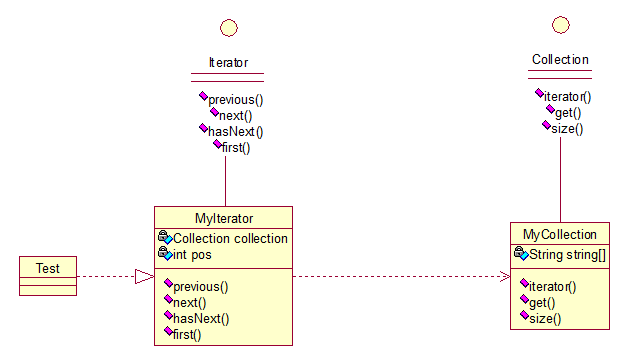Java设计模式(转)——16.迭代子模式
16.迭代子模式(Iterator)
顾名思义,迭代器模式就是顺序访问聚集中的对象,一般来说,集合中非常常见,如果对集合类比较熟悉的话,理解本模式会十分轻松。这句话包含两层意思:一是需要遍历的对象,即聚集对象,二是迭代器对象,用于对聚集对象进行遍历访问。我们看下关系图:

这个思路和我们常用的一模一样,MyCollection中定义了集合的一些操作,MyIterator中定义了一系列迭代操作,且持有Collection实例,我们来看看实现代码:
两个接口:
public interface Collection {
public Iterator iterator();
/*取得集合元素*/
public Object get(int i);
/*取得集合大小*/
public int size();
}
public interface Iterator {
//前移
public Object previous();
//后移
public Object next();
public boolean hasNext();
//取得第一个元素
public Object first();
}
两个实现:
public class MyCollection implements Collection {
public String string[] = {"A","B","C","D","E"};
@Override
public Iterator iterator() {
return new MyIterator(this);
}
@Override
public Object get(int i) {
return string[i];
}
@Override
public int size() {
return string.length;
}
}
public class MyIterator implements Iterator {
private Collection collection;
private int pos = -1;
public MyIterator(Collection collection){
this.collection = collection;
}
@Override
public Object previous() {
if(pos > 0){
pos--;
}
return collection.get(pos);
}
@Override
public Object next() {
if(pos<collection.size()-1){
pos++;
}
return collection.get(pos);
}
@Override
public boolean hasNext() {
if(pos<collection.size()-1){
return true;
}else{
return false;
}
}
@Override
public Object first() {
pos = 0;
return collection.get(pos);
}
}
测试类:
public class Test {
public static void main(String[] args) {
Collection collection = new MyCollection();
Iterator it = collection.iterator();
while(it.hasNext()){
System.out.println(it.next());
}
}
}
输出:A B C D E
此处我们貌似模拟了一个集合类的过程,感觉是不是很爽?其实JDK中各个类也都是这些基本的东西,加一些设计模式,再加一些优化放到一起的,只要我们把这些东西学会了,掌握好了,我们也可以写出自己的集合类,甚至框架!